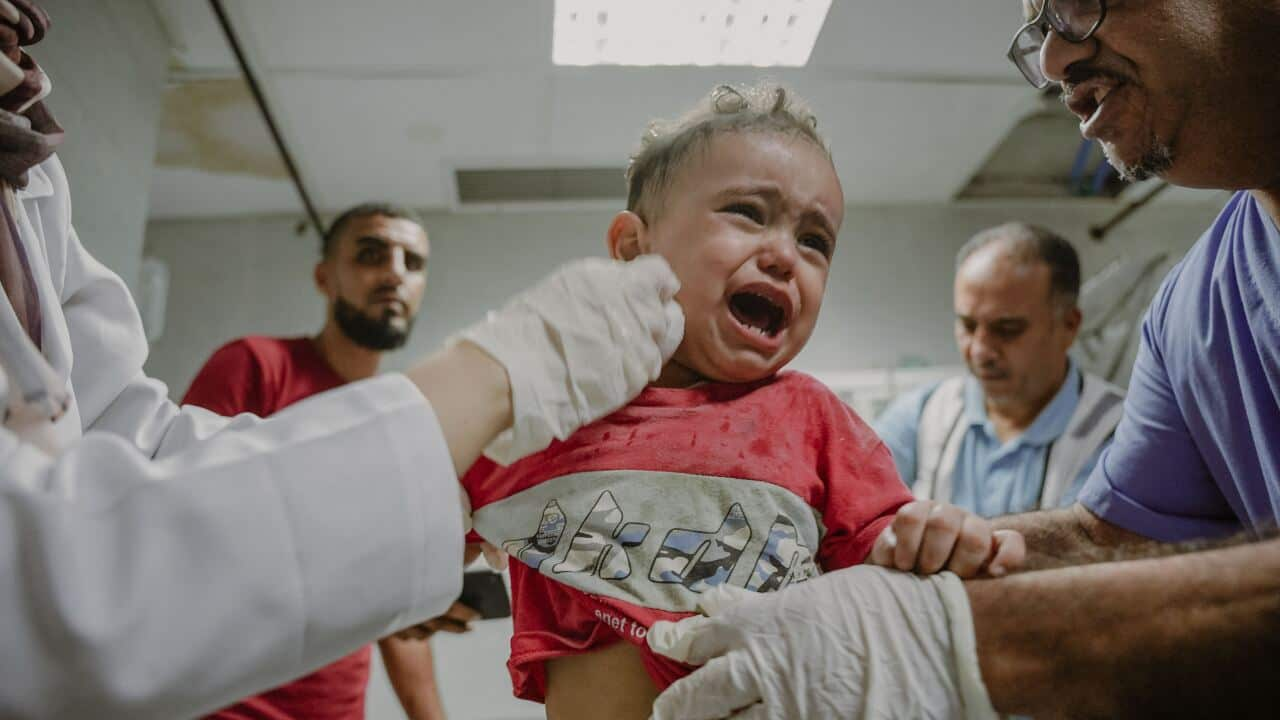Key Points
- Seventy-five per cent of school buildings in Gaza were damaged in the three months after 7 October.
- The education of all 625,000 students in the enclave has been affected by Israel's ongoing military offensive.
- Schools are being used as shelters for the almost two million people who have been internally displaced.
In a small tent on the grounds of a school in Rafah, 10-year-old Islam Aziz waits in a line for water.
The girl, like nearly two million others in the Gaza Strip, is internally displaced. She is also no longer able to attend school.
"I did not expect the war to go to this extent where we would have to go to schools (to seek shelter). We used to go to school to study, now we go to school to stand in queues to fill water and food," she told Reuters.
"We have a right to education just like all the children around the world."
Some Australian students have commenced the school year, while others will return in the coming days and weeks.
A spokesperson from the UN's agency for children (UNICEF) told SBS that most schools in Gaza have been damaged, or are being used as temporary shelters for those displaced by the crisis.
"Over 90 per cent of the schools in the Gaza Strip are either damaged or being used as shelters for displaced people," they said.
"Thousands have no home and nowhere to learn, until there is a ceasefire the situation will remain dire," the spokesperson said.
Most of Gaza's 22,000 teachers are among the displaced and rather than planning lessons their days are spent focusing on survival.

While Palestinian children who have taken shelter with their families in a school to protect themselves from Israeli attacks are not able to access formal education, they have continued studying the Quran. Source: Getty / Anadolu
The education of all 625,000 students in the Gaza Strip has been affected by school closures and attacks on education facilities, according to the report titled Education under attack in the Gaza Strip, compiled by UNICEF, Save the Children and Education Cluster.
Israel has bombarded the enclave since, according to the Israeli government.
Daily life in the Gaza Strip looks very different to a year ago.
Children's futures 'decimated'
Jason Lee, Save the Children’s country director for the occupied Palestinian territory, has described attacks against schools in the Gaza Strip as one of a number of “grave violations against children” that had been occurring.
He said Palestinian children were “paying the price for a conflict they have no part in”.
According to UNICEF, 95.4 per cent of Palestinian children were enrolled in basic education in 2018, with an almost even split between girls and boys.
Lee said the mental harm inflicted on people and the utter devastation of infrastructure including homes, schools, and hospitals had "decimated" the futures of those children who had survived Israel's offensive.
He described attacks against schools as one of a number of “grave violations against children” in Gaza.
“One per cent of the child population of Gaza has already been killed by Israeli bombardments and ground operations. Others risk being killed by starvation and disease with famine coming ever closer," he said.
Children in Gaza are focused on survival
"Children of the Gaza Strip continue to face the 'triple threat’ of conflict, disease, and malnutrition," the UNICEF spokesperson said.
According to Palestinian health authorities in Gaza, Israel's offensive has killed more than 26,000 people.
According to UNICEF, 4,327 of those were students and 231 teachers and school staff.
Children and their families in Gaza lack access to basic necessities, including food, water and proper shelter.
In a tent camp in Rafah on New Year's Day, 11-year-old Layan Harara told Reuters of her wish for the year ahead: "I wish not to die in 2024," she said.
“Our childhood is gone, there is no bathroom, no food, and no water, only tents, there is no safe space. There is nothing. Our wish is to go back to our homes, and end this,” she added.
Former teacher attempts to bring some joy
In a school in Rafah sheltering hundreds of Gazans, teacher Tareq al-Nuaimi has revived the facility as a place of learning, providing English lessons to the children staying with their families at the school.
The school used to be filled with queues of students; now it's filled with queues lining up to get clean water and food, explained al-Nuaimi.
In an attempt to bring a little joy and education to the displaced children, al-Nuaimi now provides regular English classes.
While these one-off classes may provide some semblance of schooling, it is difficult to know when formal education will once again be an option for children in the Gaza Strip.
While a temporary pause in fighting was agreed upon in November, negotiations since show no signs of bringing about a quick end to the war.
Israeli Prime Minister Benjamin Netanyahu has rejected conditions presented by Hamas to end the war.











